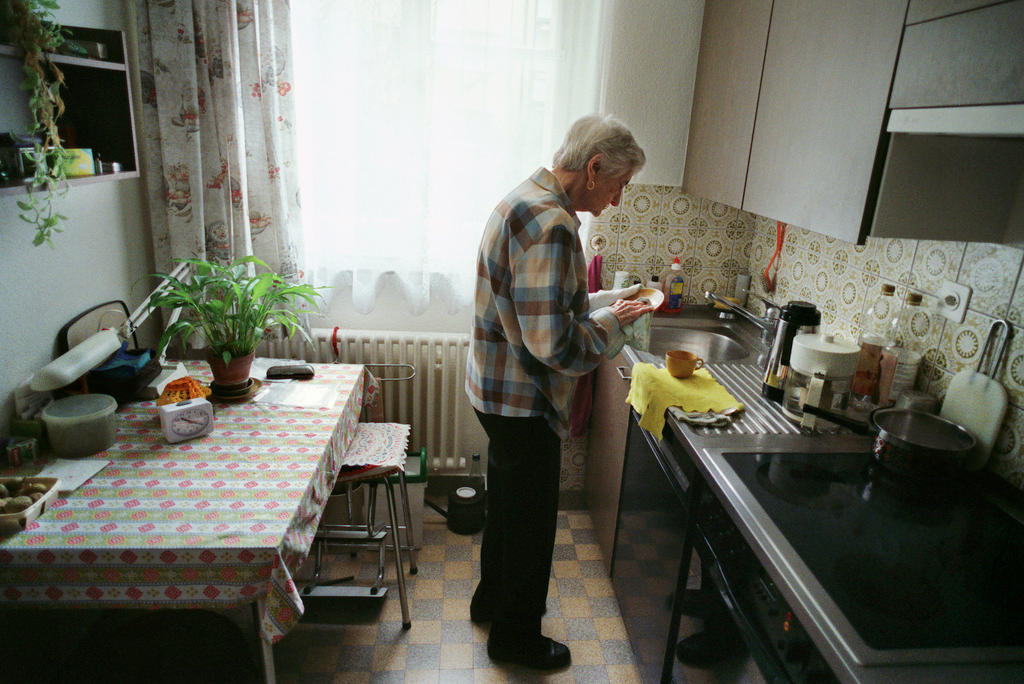Will Swiss voters increase retirement payments?

On September 25, the Swiss will vote on a people’s initiative calling for a 10% increase in payments from the state retirement fund. Can the system support an additional CHF4 billion ($4 billion) annually? Opinions differ.
Supporters of the initiative, including the Trade Union Federation (which introduced it) and leftwing political parties, see it as a solution in the fight against the ‘pension massacre’. Opponents from employers’ organisations and the rightwing and centrist parties call it “a foolish campaign with devastating consequences”.
The initiative calls for a 10% increase in state old-age pension benefits provided to all retirees through the so-called ‘first pillar’ in a three-pillar retirement system. This increase is foreseen to counteract the decrease in occupational pension payments from the second pillar, which has partially resulted from lower or even negative interest paid on occupational pension fund investments.
The Swiss constitution stipulates that a usual standard of living must be guaranteed to retirees through pension payments from the first pillar (social insurance) and the second pillar (occupational pensions).

More
Early retirements fuel pension system woes
“Since the payments from the occupational insurance are steadily declining, it’s necessary to increase the payments from the social insurance, in order to insure that the requirements in the constitution are met,” argues Paul Rechsteiner, a parliamentarian from the leftwing Social Democratic Party and president of the Trade Union Federation.
A vote at a delicate stage
The initiative will come to a vote at a time when the major reform project Retirement 2020 is under evaluation by the parliament. The 2020 project proposes a whole slew of changes which would have repercussions for the first and second pillars of the three-pillar retirement system (the third pillar being private savings).
The goal of Retirement 2020 is to ensure the financing of pensions at the current level as of the year 2020, when the Baby Boomer generation will begin to retire, causing a major strain on the pension system. Also a consideration is the increase in the average lifespan. Not only will retirees be drawing on their pensions for a longer period of time, but the two main sources of pension funding – active workers and investment income – will decline.
On September 25, when the Swiss go to the polls to vote on the pension initiative, parliament will have not yet have adopted the Retirement 2020. And yet the new legislation forms a basis for the pension initiative.
The Swiss government’s global approach to harmonising the retirement plan and the current needs of society is to find “a balance between increasing and decreasing pensions” in order to secure long-term financing, asserted Interior Minister Alain Berset when launching the campaign ahead of the vote. According to the interior minister, the initiative – which his own party supports – would threaten this delicate balance.

More
As Switzerland ages, the pension system gets stretched
Dizzying figures – say the opponents
The initiative’s opponents see the merit of Berset’s argument, even if it’s not clear what the final Retirement 2020 package will look like.
“This initiative will torpedo the reform project,” says Isabelle Moret of the centre-right Radical Party.
The politician from canton Vaud stresses that without reforms, it’s estimated that the social insurance programme will be in the red as of the year 2020, with a structural deficit of CHF800 million that will increase to CHF7 billion by 2030.
If the pension initiative is passed by voters, an additional CHF4 billion would be needed by 2018, and CHF5.5 billion more by 2030.
“At that point there would be a CHF12.7 billion gap – an enormous number – says Moret, which would lead to a massive increase in the value-added tax, and “we would all suffer from that”.
A moderate price – say the supporters
“It’s logical that you would have to pay more for a higher pension, but this is a moderate price,” responds Rechsteiner. To finance a 10% increase in state pensions would only require an additional deduction of 0.8%, divided between employer and employee, according to the proponents’ calculations.
“We shouldn’t forget that workers’ and employers’ contributions to the first pillar have remained steady at 8.4% since 1975,” says the trade union president.
That’s less than half of the amount – currently 19% on average – which is deducted from salaries to support the occupational pension scheme.
“And this is in spite of the fact that old-age pensions from the social insurance have regularly been adjusted for the cost of living, unlike those from the second pillar, which have been massively reduced,” Rechsteiner says.
The initiative: a quick look
Proponents submitted the initiative (title in German: “AHV Plus: for a strong AHV”) in December 2013. The 112,000 supporting signatures were collected in less than a year. The initiative is not supported by the seven-member Swiss Cabinet, the Senate (33 against, 9 in favour) or the House of Representives (139 against, 53 in favour). If passed, it must be implemented by the beginning of 2018.
The initiative calls for a 10% increase in old-age pension payments. Currently, a retired person who is single receives between CHF1,175 and CHF2,350 per month. A married couple receives CHF3,525 per month.
Past attempts to reform the social insurance system have all failed: in 2004 and 2010 in popular votes and in 2010 in the parliament.
The initiative’s supporters believe that a 1% increase in the value-added tax (charged on goods and services) would be enough to cover the additional money needed for the pensions of the Baby Boomers.
Boomerang effect
Opponents, on the other hand, argue that the initiative would use a scattergun approach to distribution of funds. “A 10% increase for all retirees would reward many people who have no need for additional first-pillar payments,” says Moret.
“The only people who profit would be the ones who don’t qualify for supplemental benefits or who are wealthy. The poorest people would be penalised.”
According to Moret, increasing the amount of old-age pensions would have a direct effect on supplementary benefits which are paid to people who are unable to make ends meet. These benefits would be reduced, she says, and in fact, if the initiative passes many beneficiaries of such payments would have less money in their pockets than they have now.
Rechsteiner, for his part, argues that women would benefit most from an increase in old age pensions, since it’s the only insurance scheme that takes into account childrearing responsibilities, which traditionally fall to women and don’t generate an income.
On September 25 it will be clear which argument has convinced the voters.
Adapted by Jeannie Wurz

In compliance with the JTI standards
More: SWI swissinfo.ch certified by the Journalism Trust Initiative









You can find an overview of ongoing debates with our journalists here . Please join us!
If you want to start a conversation about a topic raised in this article or want to report factual errors, email us at english@swissinfo.ch.